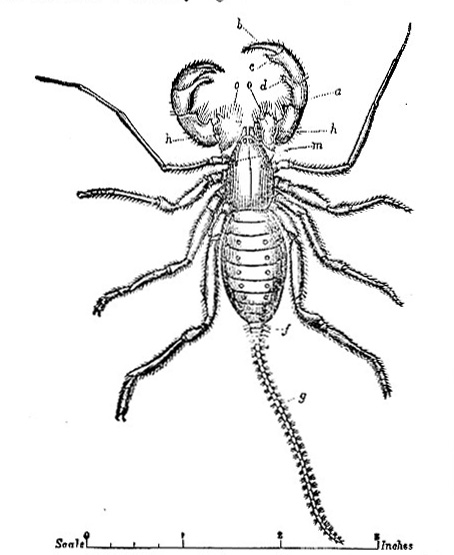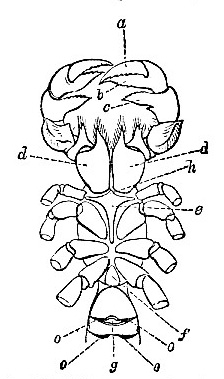(21) ARACHNIDA - ORDER VI: THELYPHONIDEA - FAMILY I: THELYPHONIDES

Fig. 21 -- Thelyphonus giganteus, Koch. a, palpus; b, movable fang or claw, forming with c, claw on fourth joint, a didactyle claw; c, claw on third joint; f, segmental elongation of abdomen, supporting tail; g, tail; h, h, falces; m, eyes; o, o, first palpal joint, with characteristic denticulations.

Fig. 22 -- Thelyphonus _____ ? portion of under side. a, movable claw of palpus; b, fixed ditto; c, claw on third palpal joint; d, d, maxillae supporting palpi; e, f, sternal plates; g, orifice of sexual organs; h, place of labium; o...o, orifices of respiratory organs.
EXTERNAL STRUCTURE (figs. 21, 22) - The cephalo-thorax is sometimes of a tolerably regular oval form, more or less blunt-pointed before, but often it is of an oblong quadrate shape, also pointed in front, and making not only the hinder part but also the fore part somewhat angular, - the latter having two obtuse lateral angles, and one acute and apical; it is of a flattened form, and destitute of hairs and spines, but is generally granulose, and sometimes covered with more marked, but still minute, tubercles. Marks of segmental soldering are visible, as also a longitudinal groove in the medial line of the caput, similar to, but less marked than, that noted in regard to the scorpions. Beneath the cephalo-thorax are two pieces, which may be regarded as small sternal plates, perhaps the terminal remains representing the complete sternum of the Araneidea, or anticipating its complete form in that order. One of these sternal plates is of a somewhat triangular form, and has its longest or apical angle directed backward between the basal joints of the first two pairs of legs; the other, more heart-shaped, and with the apical angle reversed, is situated between the basal joints of the legs of the fourth pair. In some species a minute corneous patch may be seen between the coxae, or basal joints, of the third pair of legs, affording still further evidence of the remains of a sternal plate. At the centre of the fore margin of the foremost of these sternal plates is a small point which seems to represent the labium. Beneath the fore part of the cephalo-thorax are two not very powerful falces, terminating with a long, powerful, movable, curved fang, somewhat resembling what we find in the Araneidea, and hinting at a transition to that order from the didactyle falces of the Scorpiones. Beneath, and opposed to, this fang is a fixed tooth -like claw; these parts of the mouth are thickly clothed and fringed with hairs. Immediately in front of the fore sternal plate, beneath the anterior part of the cephalo-thorax, are articulated two enormous maxillae of a subtriangular form, the apex being at the articulated part, and the inner basal angle prolonged into a larger or smaller tapeing, pointed apophysis, which is now and then denticulate. From the extremity of each of the maxillae springs a proportionately strong and massive four-jointed palpus, powerfully armed with spines, denticulations, and claw like projections; the inner extremity of the last, or digital, joint terminates like the radial (or the joint next before it), with a strong, claw-like, sharp-pointed projection, in imperfect opposition to which there is a stronger movable claw, of the same nature, articulated to the outer extremity; the fixed claw of the digital joint, with the joint itself, appear capable of being opposed at will to the fixed claw of the radial joint, thus giving the palpi a duplex kind of didactyle claw,-didactyle, that is, in a modified sense, differing as it does considerably from the terminal claw of the scorpion;s palpus, which is more properly spoken of as didactyle. The movable finger of this claw would, perhaps, be more correctly reckoned as a substantive joint, terminating with a more or less sharp corneous nail; and this joint, opposed to a pointed apophysis of the one to which it is articulated, forms the so-called didactyle claw; in fact, the terminal palpal claw of the Scorpiones (including the Pseudo-Scorpiones) as well as that of the Phalangidea, appears to be similarly constructed. In the present family, however, the basal portion of the joint, bearing the fixed claw, being far less developed (seldom stronger or more bulbous thans the other joints), and the two fingers being always of unequal length, the didactyle nature of the whole is less real, and less apparent; while in the scorpions its bulbous form is generally apparent, and often inordinate, the equal length of the two fingers and their evidently purposed opposition to each other making the claw, in the fullest sense, didactyle.
If this view (that the movable finger of this claw is a substantive joint) be correct, the palpi in the present order, as well as in the orders Phalangidea and Scorpionoidea, must be considered to have five instead of four joints, thus bringing them to an equality in this respect with the Araneidea. The palpi in the third family of this order - Phrynides - bear out this idea strongly.
The legs are long, slender, and seven-jointed, except those of the first pair, which have but six, the genual, or fourth, joint being absent. The tarsi of the first pair are divided into eight short articulations, while those of the rest have but three. There is probably some variation in the number of these articulations in different species, since Walckenaer describes the tarsi of the three hinder pairs as five-jointed; the first pair are far more slender than the rest, palpiform, and without any terminal claw; they appear, as it were, to be thrust out of their position by the great size of the maxillae, and their basal joints seem to be jammed in over those of the second pair. The tarsi of the three hinder pairs terminate with three claws, of which those of the superior pair are the strongest and curved.
The abdomen is of a long-oval form, composed of nine quasi segments, formed by a covering, both above and below, of so many transverse articulated corneous plates; while the cartilaginous membrane on each side, between the lateral margins of the upper and lower plates, is continuous, not folded or articulate as in the Scorpionidea. This is a point to be noted, as it marks a transition to the abdominal type of the Araneidea. The first plate on the upper side forms a protective covering to the pedicle by which the abdomen is united to the cephalo-thorax, and makes the pedicle look broader than it really is. There is a double longitudinal row of impressed circular spots on the upper side, two (in a transverse line) on each corneous plate, except the first and last; these impressed spots are perhaps points of attachment for muscular fibres. Beneath the abdomen, on the fourth and three following segmental plates, are eight stigmata in as many largish, shallow, circular impressions; they are, however, imperforate, and are probably, like dthose mentioned above, points for the attachment of muscles. The spiracular stigmata are four in number, two being placed beneath the hinder margin of each of the first and second sub-abdominal plates, one on each side of the median line; the genital aperture is under the hinder margin of the first plate, between the first two spiracular openings. Joined to the posterior extremity of the abdomen are three small cylindrical, post-abdominal segments, to which is attached a long setiform tail, variable in length, composed of a number of small articulations, and, like the legs and palpi, sparingly furnished with hairs; at the extremity of the third post-abdominal segment, beneath the tail, is the anal opening.
The eyes are eight in number: two place transversely, near to each other, on the fore margin of the caput in the medial line, and three others in a triangular group on each side at its lateral angles, just above the insertion of the legs of the first pair.
With regard to the INTERNAL STRUCTURE of the Thelyphonids but little appears to have been ascertained. The respiration is pulmo-branchail; the spiracular apertures being, as above stated, four in number, and situated in the position already mentioned. Their mode of reproduction is probably like that of the scorpions, ovo-viviparous, but this is conjecture only.
GENERAL OBSERVATIONS. - The family Thelyphonides is exceedingly homogeneous, and comprises but a single genus. Thelyphonus (Latr.), of which twenty-nine species only have been recorded and described, twenty six in one of the latest works upon them, by A.G. Butler, Ann. and Mag. N.H. 1872, vol. x. pp. 200-206, and Cistula Entomologica, 187e, part vi. Pp. 129-132; and three others in a still more recent paper by the late Dr Stoliczka, Journ. As. Soc. Beng., part ii. No. 2, pl. xii.
All the species of this small but remarkable group are confined to the tropical regions of Asia, America, and Australasia, no species having yet been recorded from Africa. In size they vary from rather more than half an inch to 2 or 3 inches in length. Among other characters useful in the identification of the species, are the number and differential development of the various processes and denticulations of the palpal joints. Of their habits little is known, and much of that little is of a very recent date. Dr Stoliczka (l.c.) gives a short account of them, from which it appears that they are nocturnal or crepuscular, living by day in damp places under the bark of old trees; when disturbed they hold up the palpi, as if for defence, and beat a rapid retreat, with the tail in an erect position. In this position of the tail we see a curious relationship to the scorpions, but apparently without the same necessity, in the present instance, for such a position. They lie still when uncovered, evidently simulating (though of course unconsciously) a fragment of old bark or fungus. The first pair of legs act more as feelers than as organs of locomotion. In the presence of a sternal plate. The mode in which the abdomen is united to the cephalo-thorax, and the structure of the falces, Thelyhonids approach nearer than the scorpions to the structure of the true spiders, and, as we shall see, the family Phrynides is a transitional group bridging over some part of the gap between the two, while in the massive palpi (though imperfectly didactyle), and in some other respects, they show an unmistakable alliance to the scorpions.
Read the rest of this article:
Arachnida - Table of Contents
|

